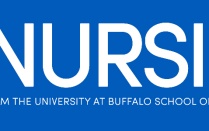Going Gentle Into That Good Night

Published November 29, 2017 This content is archived.
Lessons from a nursing student's hospice internship
By Sarah Goldthrite
“The first day of my hospice internship, I went out with an admissions nurse and we admitted a patient who was experiencing delirium. He was my very first patient there,” says 23-year-old nursing student Sarah Dow. “During my last day on the unit, he passed away. It was so illuminating to experience the whole spectrum – I came full circle in understanding that transition.”
During the summer of 2016, Dow took part in Hospice Buffalo’s first internship program – a serendipitous opportunity for nursing students in Buffalo, an important location in hospice history.
“What makes Buffalo unique in terms of hospice care is that we have one of the oldest, most established hospice programs in the country,” says Christopher Kerr, chief executive officer and chief medical officer at Hospice Buffalo. “Hospice is a nurse-led movement and delivery model, and a Buffalo nurse, Charlotte Shedd, was one of the movement’s early pioneers.”
Dow, following in the footsteps of her nursing predecessors, spent eight weeks of her summer – four in inpatient care and four in outpatient care – working with hospice patients and professionals. Here, she would comfort those facing death, or the death of a loved one – a role in which she settled quite naturally, and one in which she has found herself at various points throughout her life.
“I’ve always been a spiritual person,” Dow says. “I grew up Catholic and have kept that faith throughout my life. As a [child], I was in music ministry and would sing at funerals, so I was always involved with the death aspect of spirituality.”
Prior to the Hospice Buffalo internship, Dow completed her pediatric rotation with Hospice Buffalo’s Essential Care for Children program, which provides medical services and support to children and families of children facing life-limiting illness.
“It’s comforting to be able to lend support to families – to help them grieve – whether through voice or talking or counseling. I find ease in it, and I think it’s special,” Dow smiles. “I’ve always seen death as a positive experience. It’s a point where people are taking that next step in their spiritual lives.”
Dow’s age does not preclude her passion for or understanding of a “good death” – a concept that seems counterintuitive to most, as we are hardwired to dodge death at every turn.
Hospice care professionals and students like Dow share a unique affinity for helping patients and their families through the dying process. They focus on each individual’s need, relieving physical and mental pain for patients, caregivers and family members.
“Being patient-centered and being able to develop a rapport with patients – whether having a conversation or providing basic care like morning hygiene – is very important,” especially in hospice care, Dow has learned, despite the impending loss.
“It was so enlightening to be able to sit down and talk with a patient for an hour rather than just a few minutes at a time,” says Dow. “I feel our souls can connect during our conversations, which is so empowering.”
Dow’s experiences have helped her understand the importance of palliating both physical and spiritual pain. She emphasizes that working through a patient’s sadness or depression is just as important as physical comfort. Sometimes, she says, this could be medication. Other times, it is a conversation or a redirection of their attention to birds chirping outside their window.
“Patients may have difficulty passing if they’re in physical or emotional pain, or if they’re uncomfortable,” Dow explains. “By managing all of those symptoms, we can help them with that transition and their new path, enabling them to have a peaceful death.”
“It is necessary to recognize people facing death suffer in totality, so care should be comprehensive at the end of life to match that need, for both the patient and the patient’s family,” says Kerr. “Nurses, social workers, pastors, counselors and volunteers work together to address their psychological, social, practical and spiritual needs.”
“It was so helpful to be able to sit around a table with all of these different disciplines,” Dow says. “We were able to give each other feedback and better understand each patient’s needs, and the needs of the family. It’s a beautiful thing to be a part of that.
“Working in hospice really teaches you to look at the patient as a whole and the family as a whole. In some settings, that’s not always easy – but for me in my practice that’s going to be a priority.
“I think I will eventually end up back in hospice,” Dow says. “I loved it. I loved going to work every day, and I was excited to talk with the patients – it was so enlightening.”
In the meantime, Dow plans to gain more experience in oncology, with the aim of better understanding some hospice patients’ experiences. This way, she can better fulfill her duty to aid in a good death – a peaceful death – physically, emotionally and spiritually.
Read More UBNursing
Current Issue
Past Issues
We want to hear from our incredible alumni. Whether you live in Western New York or anywhere else in the world, stay in touch! Send us a class note.

